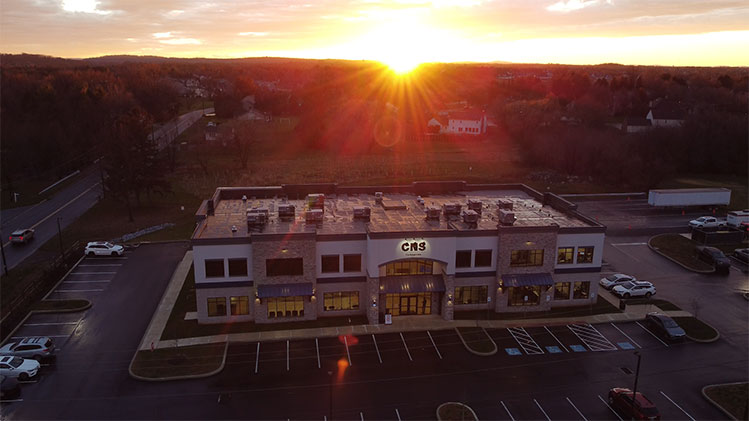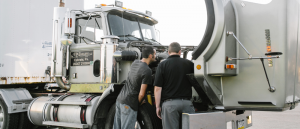Furry Friends Cause Trucking Border Delays At Canadian Border
To prevent reintroduction of rabies carried by dogs into the United States, new CDC regulations require proof of healthy pets at border crossing. Truckers who
We are a team of DOT Compliance and Licensing Professionals helping trucking and transportation companies remain safe, compliant, and profitable.
CNS or Compliance Navigation Specialists is DOT Compliance company that assists trucking and transportation companies remain DOT Compliant. We are part of a network of companies, CNS Companies, specializing in services related to the transportation, manufacturing, construction, service, education and medical industries.

A full-scale DOT Compliance Program managing a long haul carrier’s safety, compliance, licensing and more.
Learn more >>>
A DOT Compliance Program that keeps motor carriers compliant with the 6 Basic DOT Regulations required of all carriers.
Learn more >>>
Our Short-Haul/Construction Program is a full-scale program designed for private carriers that do not haul for-hire.
Learn more >>>
Our most comprehensive DOT Compliance Program, operating as your company’s off-site Safety Director or assisting your current safety personnel.
Learn more >>>
Our Non-CDL Program is a full-scale program managing safety, compliance, licensing and more for moving companies, couriers, landscapers, or any company subject to DOT regulations and does not employ CDL drivers.
Learn more >>>
Our DOT Audit Services cover a number of different types of DOT Audits that new and existing carriers will be subject to.
Our DOT Driver Services help trucking companies and carriers to stay compliant as they grow and hire more drivers.
Our DOT Vehicle Services focus on ensuring your vehicles are compliant with DOT Regulations, which is just as important as your drivers.
Our DOT Services for Special Carriers focus on companies outside of the typical motor carrier, like HAZMAT, Passenger and Bus Carriers.
CNS is part of a group of companies that offer other necessary services for the trucking and transportation industry, such as Commercial Trucking Insurance, CDL Training, Online Training Course, and even Healthcare.
Our DOT Licensing Services will cover you whether you are an existing company or just starting a trucking company. Our DOT Licensing Specialists can help you get up and running and in days with your DOT number, MC Authority, EIN, UCR, IFTA, 2290 HVUT, Fuel Taxes and can even set you up to get your Commercial Driver's License (CDL) with CNS Driver Training Center.
Our DOT Licensing Specialists will help you with every aspect of starting a trucking company. All you need to do is choose a name for your trucking company.
You will need to ensure your DOT Number, MC Authority, Vehicle Registration, etc. is all set up properly when you start your trucking business.
Our Licensing Specialists can help with all aspects of filing and renewing licenses, fuel taxes, etc.
CNS is part of a group of companies that offer other necessary services for the trucking and transportation industry, such as Commercial Trucking Insurance, CDL Training, Online Training Course, and even Healthcare.
To prevent reintroduction of rabies carried by dogs into the United States, new CDC regulations require proof of healthy pets at border crossing. Truckers who
CNS or Compliance Navigation Specialists is DOT Compliance company that assists trucking and transportation companies remain DOT Compliant. We are part of a network of companies, CNS Companies, specializing in services related to the transportation, manufacturing, construction, service, education and medical industries.
CNS Companies is a network of companies specializing in services related to the transportation, manufacturing, construction, service, education and medical industries. Our DOT Compliance division is handled by Compliance Navigation Specialists, CNS Insurance handles Commercial Truck Insurance, CDL training is managed by the CNS Driver Training Center and healthcare is managed by CNS Occupational Medicine.
We are a team of DOT Compliance and Licensing Professionals helping trucking and transportation companies remain safe, compliant, and profitable.
CNS or Compliance Navigation Specialists is DOT Compliance company that assists trucking and transportation companies remain DOT Compliant. We are part of a network of companies, CNS Companies, specializing in services related to the transportation, manufacturing, construction, service, education and medical industries.

A full-scale DOT Compliance Program managing a long haul carrier’s safety, compliance, licensing and more.
Learn more >>>
A DOT Compliance Program that keeps motor carriers compliant with the 6 Basic DOT Regulations required of all carriers.
Learn more >>>
Our Short-Haul/Construction Program is a full-scale program designed for private carriers that do not haul for-hire.
Learn more >>>
Our most comprehensive DOT Compliance Program, operating as your company’s off-site Safety Director or assisting your current safety personnel.
Learn more >>>
Our Non-CDL Program is a full-scale program managing safety, compliance, licensing and more for moving companies, couriers, landscapers, or any company subject to DOT regulations and does not employ CDL drivers.
Learn more >>>
Our DOT Audit Services cover a number of different types of DOT Audits that new and existing carriers will be subject to.
Our DOT Driver Services help trucking companies and carriers to stay compliant as they grow and hire more drivers.
Our DOT Vehicle Services focus on ensuring your vehicles are compliant with DOT Regulations, which is just as important as your drivers.
Our DOT Services for Special Carriers focus on companies outside of the typical motor carrier, like HAZMAT, Passenger and Bus Carriers.
CNS is part of a group of companies that offer other necessary services for the trucking and transportation industry, such as Commercial Trucking Insurance, CDL Training, Online Training Course, and even Healthcare.
Our DOT Licensing Services will cover you whether you are an existing company or just starting a trucking company. Our DOT Licensing Specialists can help you get up and running and in days with your DOT number, MC Authority, EIN, UCR, IFTA, 2290 HVUT, Fuel Taxes and can even set you up to get your Commercial Driver's License (CDL) with CNS Driver Training Center.
Our DOT Licensing Specialists will help you with every aspect of starting a trucking company. All you need to do is choose a name for your trucking company.
You will need to ensure your DOT Number, MC Authority, Vehicle Registration, etc. is all set up properly when you start your trucking business.
Our Licensing Specialists can help with all aspects of filing and renewing licenses, fuel taxes, etc.
CNS is part of a group of companies that offer other necessary services for the trucking and transportation industry, such as Commercial Trucking Insurance, CDL Training, Online Training Course, and even Healthcare.
To prevent reintroduction of rabies carried by dogs into the United States, new CDC regulations require proof of healthy pets at border crossing. Truckers who
CNS or Compliance Navigation Specialists is DOT Compliance company that assists trucking and transportation companies remain DOT Compliant. We are part of a network of companies, CNS Companies, specializing in services related to the transportation, manufacturing, construction, service, education and medical industries.
CNS Companies is a network of companies specializing in services related to the transportation, manufacturing, construction, service, education and medical industries. Our DOT Compliance division is handled by Compliance Navigation Specialists, CNS Insurance handles Commercial Truck Insurance, CDL training is managed by the CNS Driver Training Center and healthcare is managed by CNS Occupational Medicine.
For now, truckers should be able to cope, as the market is still affected by supply chain challenges and “driver shortages”. But what if the downturn gets worse, leading into a recession? What can you do to lower your risk in a weaker industry?
Many owner-operators, unlike larger fleets, buy fuel at the pump price. With those prices soaring and sometimes a considerable lag of cashflow with 30+ days to receive payments after finishing a load, the recent rate drop and fuel hike creates a tricky situation. This means there could be a trucking bloodbath on the way for owner-operators and new venture carriers.
We expect the owner-operator to bear the brunt during a freight recession, especially new-to-the-market owner-operators who purchased used trucks at record-high prices. They will have to auction their trucks or go back to truckload carriers. And here lies the problem. Used truck prices soared due to a shortage of new equipment. Of the 130,000 new carriers since the pandemic, the majority are one or two truck operations driving used trucks.
So, what can be done to recession-proof your fleet?
Are you doing everything you can to reduce risk?
Generally, trucking companies with minimal loss activity are in a better position to gain access to more insurers with better pricing.
One secret in the insurance industry is that carriers who prove their low-risk safety history will get much lower preferred rates as they go into their third year of business.
To an underwriter, the story your public records tell determine how risky you are. The most common areas that hurt a carrier’s safety history are any professional, personal, and financial issues that underwriters have access to that show high risk.
It is time to:
All fleets should be proactive, not reactive, when it comes to DOT compliance and safety management.
Passive safety programs are inadequate and can lead to increased fines and fleet risk, especially when it comes with DOT compliance and driver management.
According to FMCSA closed enforcement cases for the last five years, carriers’ average costs of non-compliance was settled for $7,000 per carrier! On top of this, it can cost a carrier an additional $870 of downtime when a driver was placed out-of-service for 10 hours.
Regardless of what you haul or what industry your fleet is in, being proactive in safety management is crucial in keeping compliance fines and driver management costs low.
Proactive safety management means you and your company are working hard to be safe, compliant and stay ahead of the FMCSA.
It is time to:
Carriers being proactive will put them in a better position to mitigate risk, improve efficiencies, reduce costs, and spend more time with their drivers in an effort to manage a safe and compliant fleet.
With proactive safety, carriers will be more organized and will have a measured plan to lower motor carrier Safety Measurement System (SMS) scores.
When partnering with a third-party program, your fleet has a team of experts that costs much less than hiring a safety director or team and can receive constant monitoring to keep your operation FMCSA compliant. Driver management will be simplified and the driver hiring process will shorten.
While data and paper management can be crucial, using a third-party partner will help you be prepared for audit representation, provide document storage, and offer up-to-date company policies and handbook of FMCSA rules and regulation changes.
Not only will proactive safety help your fleet with DOT compliance, but it is proven to lower insurance premiums as you will have documented ways to show a reduction in risk.
One of the biggest challenges for carriers is cash-flow.
There are costs paid out up-front before you even move a load, including: insurance, equipment investments, operating authority, fuel, maintenance costs, etc. Slow paying customers are also a problem, over 30 days to get paid.
The biggest reason owner-operators fail is not having enough money saved up before going on their own to manage start-up costs, maintenance emergencies, or lagging payments after finishing a load.
On average it takes 35 to 45 days to receive payment after completing a load.
To take control of your cash-flow:
What about factoring?
One way truckers mitigate start-up expenses is factoring.
Factoring is the selling of the invoice after you complete the load to the factoring company.
Doing this allows you to get paid that same day, but with a cut for the factoring service. Carriers then use that cash to fund operating expense moving forward.
The goal here is to look for good factoring rates.
In the past, factoring companies would take 10% or more for their service. But we are seeing numbers closer tp 5% right now, which is much more reasonable.
If you do not have the cash-flow, this is an opportunity during the market downtrend until things get better.
If you are thinking about buying or leasing a new or used tractor or trailer, it is important to understand the cash-flow management with your choices as well.
Should you purchase or lease a new or used truck?
As your most expensive and most important asset, a used truck will likely cost around $60,000 or more while a new truck will cost around $100,000 or more.
To get a new truck, most dealerships require two years of driving experience, a clean driving record, 20% down payment, and a credit score of at least 650.
Many new owner-operators cannot afford to put 20% down and will often choose to lease the truck with around a $1,000 down payment.
In the short-term, leasing is always cheaper because leasing focuses on the value of the truck at the end of the lease term lowering the initial investment with an option to purchase or refinance for the remaining value of the truck after the lease ends.
For example, a $150,000 truck is leased-to-own for 4 years. After 4 years, the value of the truck is worth $50,000. So, during your lease, you are paying off the difference in value of $100,000 and then still owe $50,000 at the end.
Now, during the last 4 years, your business plan would be to save money to purchase the rest of the value of the vehicle at the end of the lease or refinance for the residual left on the truck.
The average cost to lease a semi-truck is between $1,600 to $2,500 per month for new trucks and $800 to $1,600 per month for used trucks. Don’t forget that there is still likely around a $1,000 down payment if you’re leasing from a dealer.
Typically, fuel is the largest operating costs in a trucking company and the average truck today can consume more than 20,000 gallons of fuel a year, costing more than $70,000.
According to the American Trucking Association, drivers who practice fuel-efficient driving techniques use about 35% less fuel than those who do not.
Beyond using aerodynamic kits, saving fuel is not that difficult and slight modifications can help you achieve greater efficiency.
The secret of good fuel economy requires overcoming:
Overcoming Air Drag
Air resistance is the most significant contributor to vehicle power requirements, especially over the speed of 50 mph.
Minimizing the height of the load will save fuel by reducing the air drag on the vehicle. Most tractor trailers have roof mounts that deflect airflow over the highest point at the front of the trailer load.
In addition to overhead deflectors, we see devices that seal the gap between the tractor and trailer, sealing the trailer underbody, and trailers adding a boat tail. These aerodynamic devices can reduce the horsepower required to move the truck by as much as 35 horsepower.
Overcoming rolling resistance
As the second most significant contributor to vehicle power and fuel consumption, rolling resistance is the energy required to maximize the movement of tires on a roadway.
The factors that influence rolling resistance include:
It has been demonstrated that checking tire pressure regularly and keeping an eye on tread wear can achieve up to 0.5 mpg as losing 10 pounds of tire pressure can lead to a 1% decline in fuel economy.
Speeds above 50 mph lead to more friction on the roads, higher tire temperatures, and reduced fuel economy. This leads to a decrease of 0.1 mpg for every mile per hour over 55 mph.
Overcoming gravitation pull
Overcoming or utilizing gravity to your advantage is most important during steep grades. When moving a loaded vehicle up a grade, the only variable you can influence is speed.
To improve fuel efficiency–in rolling terrain–use a light throttle and allow momentum to carry the vehicle over short grades.
In hilly and mountainous terrain, use the engine’s entire operating range before gearing down, where possible.
When cresting steep grades, use gravity to bring the vehicle back to the desired cruising speed.
You can also improve fuel economy when you balance the load between your drives and trailer tandems with slightly more on your drive axles.
Overcoming unnecessary wastefulness.
It is the driver’s goal to arrive on time while incurring the least expense.
To reduce wasteful driving, you can:
Building relationships with your customers, while generally being interested in how they conduct their business, will strengthen that relationship.
A happy customer will expand your book of business through word-of-mouth referrals.
One of the most important skills to learn as a new carrier is how to find loads and maintain a solid list of customers.
The goal is to be a part of the shipper’s supply-chain and being an asset to their success.
You can use these shippers for referrals, reviews, and more.
If you are just starting out, start cold calling local shippers in your area and start building a relationship since local shippers may be in the market for an exclusive driver.
What are some steps and considerations when starting out?
Remember, you are not the only driver out there, so diversify your business across multiple shippers to ensure steady business.
Also, having a loyal repair shop will also get you the best rates.
The last option to consider are the local, state, and federal governments transportation needs.
Unlike other types of loads, you will have to first register as a government contractor to be able to haul their load or partner with another company who is already under a government contract.
Either way, you should contact your state or city government for more details if you are interested in fulfilling government trucking contracts.
If you have a Class A CDL, you will always be able to find a driving job, but how much you make depends on what you are hauling or how well you are taking advantage of trucking’s four seasons.
This goes hand-in-hand with cash-flow management and the importance of being paid for every-mile, decreasing deadhead miles.
Being aware of the seasonal pattern is important to know where supply and demand are being concentrated and how to take advantage of it.
Let’s walk through what the trucking season looks like so you can manage your cashflow well.
Just a word of causion, we have seen some companies chase good rates in one state, but they cannot find good rates coming out, so either accept cheap loads (bad rates) or are increasing deadhead miles. Efficiency and accepting good rates is the key keeping good cash-flow coming in.
January – March = The Quiet Months
After the holiday season, freight volume is down, and the trucking industry remains quiet as many drivers don’t want to drive in the winter weather or are resting before the trucking cycle picks up again.
There is still plenty of work to do, but you will likely see shorter runs and 10-20% less miles.
Around March, freight volume starts picking back up as we are getting closer to spring months.
For example, cross-border Mexico produce peaks in early March and Texas starts to see fruits and onions begin harvested.
Also, early spring is when nurseries, commercial growers, and tree farms are starting to ship seedlings and saplings on pallets to the market to meet the spring planning demand.
April – July = Produce Season/Reefer Season
As temperatures rise, so does regional produce shipping, starting from southern states (Florida, Georgia, Texas, New Mexico and California), then the Carolinas and Northern California, and finally the Northeast, Midwest and Pacific Northwest.
You don’t have to ship produce to be affected by produce season because there is typically an average load to truck ratio of 3:1 during this season.
If you are hauling food, fresh produce can only be transported using refrigerated trucks. Reefer loads are tighter and freight rates can increase up to 30%.
In certain regions, the capacity and rates change drastically for non-produce shippers, as carriers are massively switching to high-paying produce loads.
For example:
During this time, it’s crucial to research your regions of interest to understand how much you may be affected by produce.
Flatbed shipping is highly dependent on the weather as well, dependent upon construction and capital expenditures. If you are not shipping produce, or there is a lull between the start of the next regional produce season, then flatbed shipping is where you need to be.
*Note: China has been locked down for nearly a month as they battle through their zero-COVID policy. With almost a quarter of unberthed ships stuck outside Chinese ports (412 ships, up 58% since February), US ports will be hit hard in June or July, causing a high demand for truckers.
July – October = Peak Shipping Season
As produce season moves to the Northeast, Midwest and Pacific Northwest, shippers are preparing for the holidays and the back-to-school time of the year.
Sales are typically up and companies are actively shipping products in and out of warehouses to ensure they are ready for the holidays.
This means rates and volume are peaking and the roads are busy with freight.
If you haven’t already, start stashing away profits to prepare for emergencies or the winter lull.
November – December = Holiday Season
Holidays are coming, making this season see surging rates as companies push to get last-minute orders in and shipped to store shelves.
Carriers can find high-paying loads as businesses are shipping overlooked products, delayed products, or last-minute items. Drivers can often see 10 -20% more miles during these months.
Towards the end of this season, carriers and truck drivers begin to take time off before the trucking cycle restarts.
With high fuel prices, low rates, and fears of a trucking recession, carriers must find ways to efficiently run their business.
In a tight economy, carriers and drivers need to reduce unnecessary costs, focus on preventative maintenance, and reduce any deadhead miles.
From a driving perspective, it is more important than ever to encourage proper trip planning because a well planned trip is profitable.
While this is common knowledge, we know that many drivers are not practicing good trip planning or journey management.
A lot of new drivers don’t give trip planning the attention it deserves or lack sufficient training on this topic.
Here are 12 tips for proper trip planning and journey management:
Even if spot rates continue to decline, owner-operators can take their trucks into contract work with big fleets.
If you are tired of fighting for good load rates from brokers, then this is an option to explore, because accepting cheap rates continues to hurt everyone.
Many shippers are in the middle of negotiations, as motor carriers have given an initial offer, then calling in to say they would like to adjust it down even further to protect their revenue. That is happening right now.
Just be careful with insurance and safety history when leasing with a carrier.
You need to make sure that the carrier offers coverage levels that meet your specific insurance needs as it will impact your eligibility to haul certain cargo and can affect your bottom line.
If leasing on, it is important to understand that the carrier sets all the terms.
For example, you may not have the ability to choose your own routes, schedule, length of term, charges for services, or termination process.
When leasing on, be sure to read the insurance fine print closely and ask questions to understand what is covered or not since it may not cover you while you are not operating under that company’s authority.
Additionally, see if you are covered when hauling for other companies or traveling home when you are off duty.
Lastly, make sure that the carrier offers coverage levels that meet your specific insurance needs as it will impact your eligibility to haul certain cargo and can affect your bottom line.
Issues moving away from being leased on with a carrier
If you want to separate from a carrier and go on your own, that can present a big problem.
When an owner-operator leaves a lease agreement to go on their own, they have no safety history under their own authority.
So, you are basically starting over unless an underwriter can get the data from that motor carrier, with all the claims, by driver.
If you used the carrier’s equipment and are only asked to get a non-trucking liability or bobtail liability, that does not count as primary insurance. Underwriters can’t use non-trucking or bobtail liability for proof that they had no incidents.
To decide if insurance through a carrier is right for you, think about your future goals, such as expanding your business or eventually running under your own authority.

If you have a Class A CDL, you will always be able to find a driving job, but how much you make depends on what

With high fuel prices, low rates, and fears of a trucking recession, carriers must find ways to efficiently run their business. In a tight economy,

Examining problems is crucial for your fleet’s growth. Here’s how to do it. Let’s get real for a second. If you don’t examine your failures,

Inflation is affecting everything from diesel prices to DOT fines. As of March 21, 2022, the DOT increased the fine amount for trucking violations to

When it comes to driver training, the conversation at many fleets goes like this: “What if we train everybody and they leave?” – CFO “What

In 2019, FMCSA data shows that nearly half of the 54,000 DataQs were filed for inspections/crashes assigned to the wrong carrier or driver (for example,

According to the American Trucking Association, drivers who practice fuel-efficient driving techniques use about 35% less fuel than those who do not. Typically, fuel is

All fleets should be proactive, not reactive, when it comes to DOT compliance and safety management Fleets that say they care about putting “safety first”

The three areas that most violations come from are lights, tires, and brakes Teaching a driver how to do a pre-trip and post-trip inspection is
Join our monthly newsletter and stay up-to-date on trucking industry news and receive important compliance and licensing tips.
Join our monthly newsletter and stay up-to-date on trucking industry news and receive important compliance and licensing tips.